09:30 – 11:30
Strategies for an adequate, positive and efficient contact and interaction with people with ASD
Reflect 1, Reflect 2, Reflect 3
Discuss and Overview 1
Features of community services and their impact on usability for people with ASD
Think & Reflect
#4. Introduce the content Strategies for an adequate, positive and efficient contact and interaction with people with ASD. In the end, ask for comments, doubts, or questions
Note: Present slides number 9 to 12
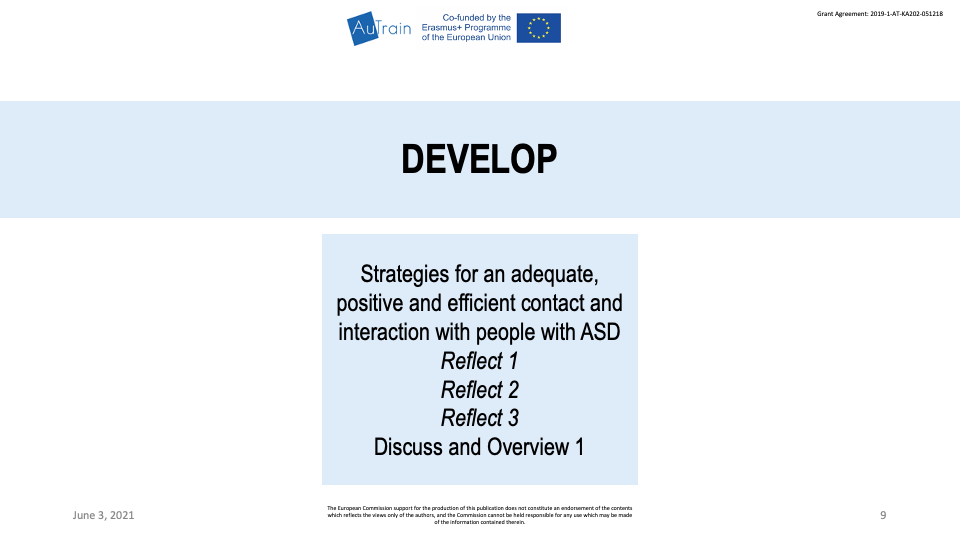
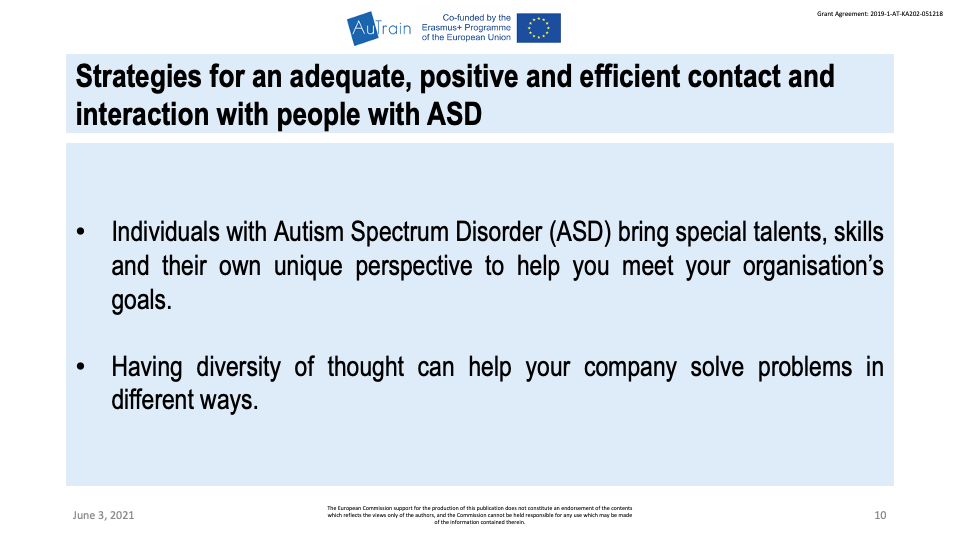
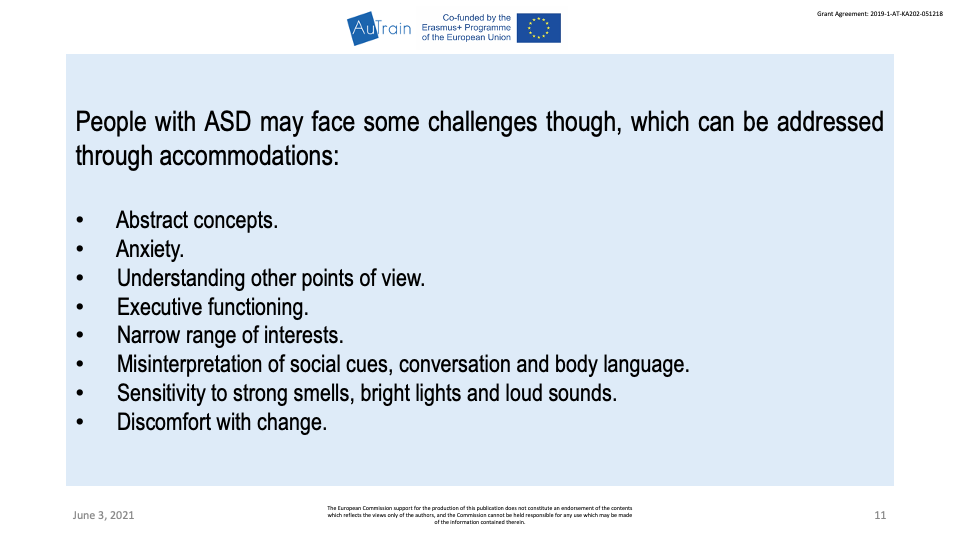
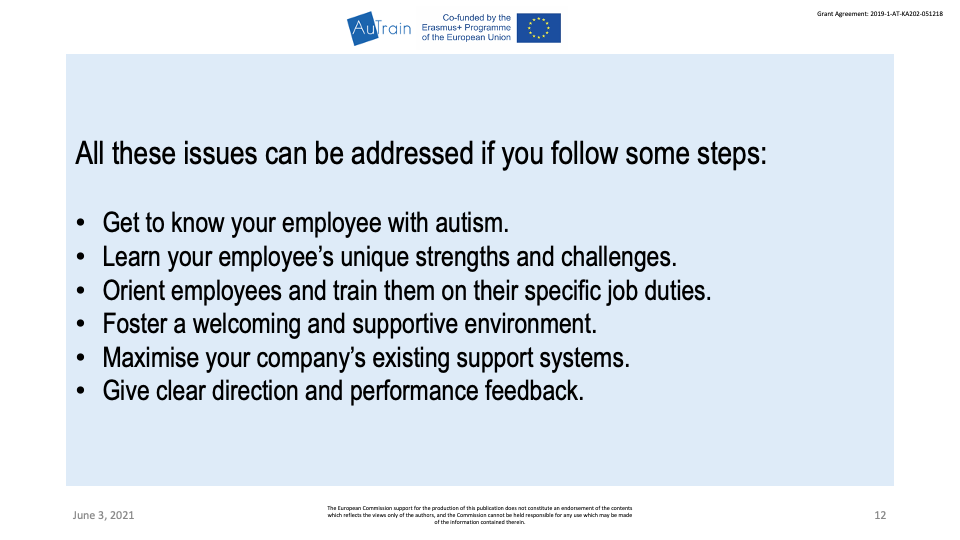
Strategies for an adequate, positive and efficient contact and interaction with people with ASD
- Individuals with Autism Spectrum Disorder (ASD) bring special talents, skills and their own unique perspective to help you meet your organisation’s goals. –
- Having diversity of thought can help your company solve problems in different ways.
People with ASD may face some challenges though, which can be addressed through accommodations:
- Abstract concepts.
- Anxiety.
- Understanding other points of view.
- Executive functioning.
- Narrow range of interests.
- Misinterpretation of social cues, conversation and body language.
- Sensitivity to strong smells, bright lights and loud sounds.
- Discomfort with change.
All these issues can be addressed if you follow some steps:
- Get to know your employee with autism.
- Learn your employee’s unique strengths and challenges.
- Orient employees and train them on their specific job duties.
- Foster a welcoming and supportive environment.
- Maximise your company’s existing support systems.
- Give clear direction and performance feedback.
Ask for comments, doubts, or questions
Note: Present slides number 13 to 18
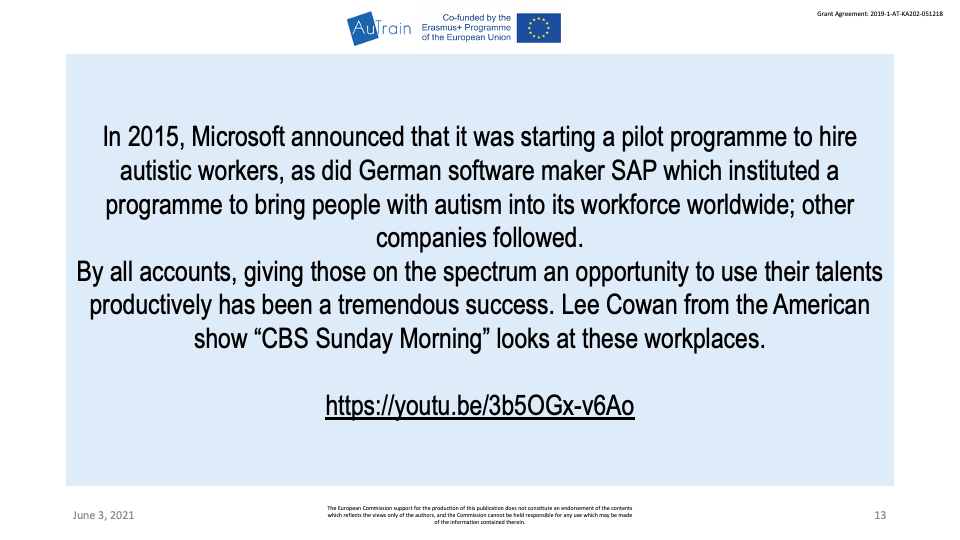
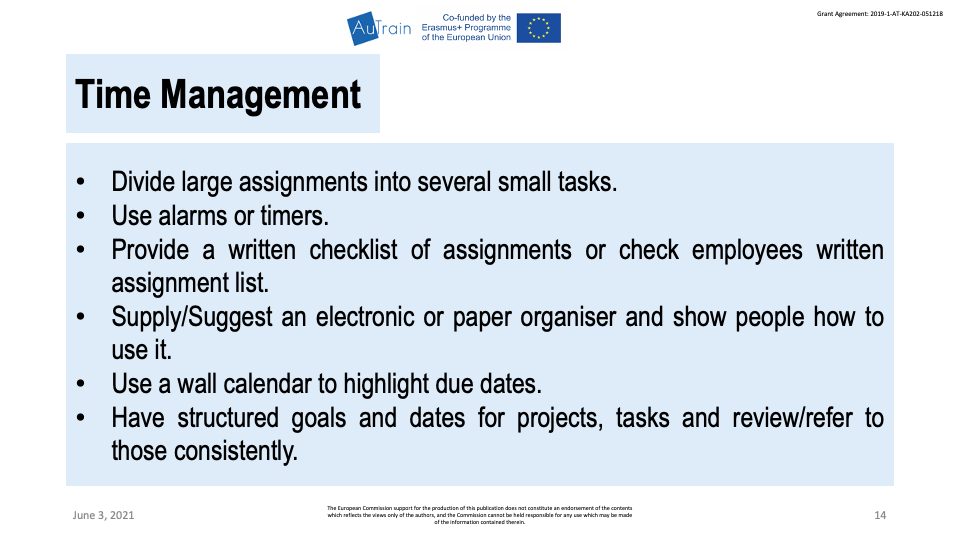
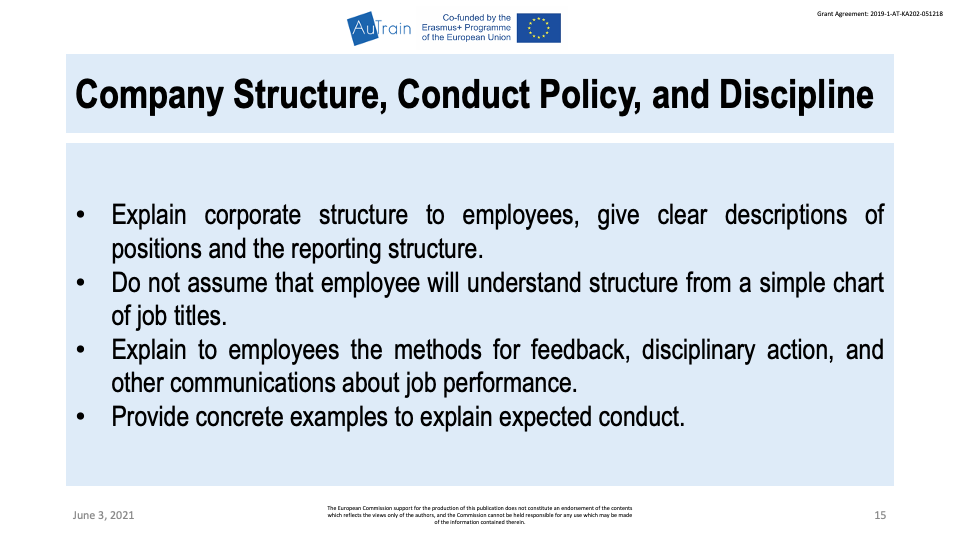
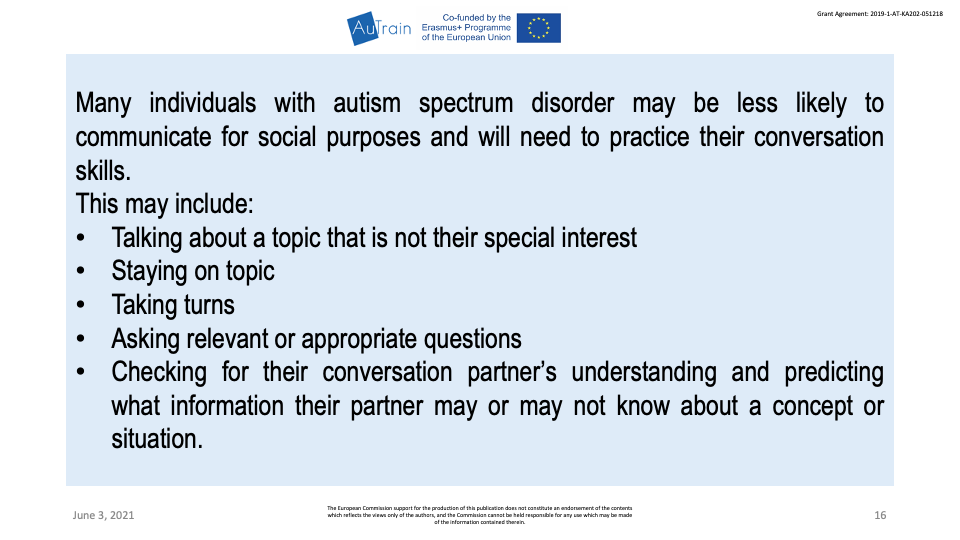
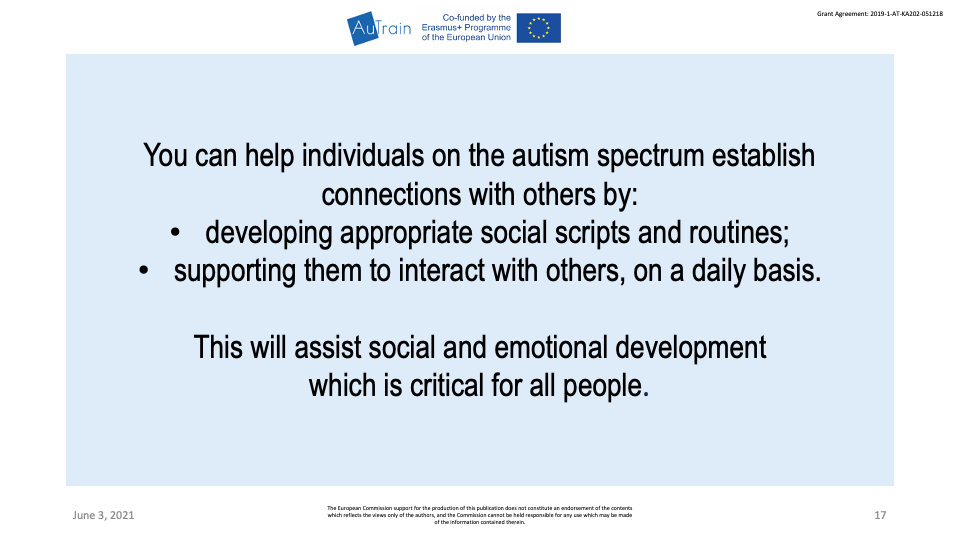

In 2015, Microsoft announced that it was starting a pilot programme to hire autistic workers, as did German software maker SAP which instituted a programme to bring people with autism into its workforce worldwide; other companies followed.
By all accounts, giving those on the spectrum an opportunity to use their talents productively has been a tremendous success. Lee Cowan from the American show “CBS Sunday Morning” looks at these workplaces. https://youtu.be/3b5OGx-v6Ao
Time Management
- Divide large assignments into several small tasks.
- Use alarms or timers.
- Provide a written checklist of assignments or check employees written assignment list.
- Supply/Suggest an electronic or paper organiser and show people how to use it.
- Use a wall calendar to highlight due dates.
- Have structured goals and dates for projects, tasks and review/refer to those consistently.
Company Structure, Conduct Policy, and Discipline
- Explain corporate structure to employees, give clear descriptions of positions and the reporting structure.
- Do not assume that employee will understand structure from a simple chart of job titles.
- Explain to employees the methods for feedback, disciplinary action, and other communications about job performance.
- Provide concrete examples to explain expected conduct.
Many individuals with autism spectrum disorder may be less likely to communicate for social purposes and will need to practice their conversation skills. This may include:
- Talking about a topic that is not their special interest
- Staying on topic – Taking turns
- Asking relevant or appropriate questions
- Checking for their conversation partner’s understanding and predicting what information their partner may or may not know about a concept or situation.
You can help individuals on the autism spectrum establish connections with others by:
- developing appropriate social scripts and routines;
- supporting them to interact with others, on a daily basis.
- This will assist social and emotional development which is critical for all people.
Individuals in the spectrum will read our emotional level about a situation.
- Use a calm tone of voice, even in the midst of a behavioural outburst.
- Practice your anger management techniques.
- By using a respectful and proactive approach, the individual will build self-esteem, confidence, and reduce anxiety.
Ask for comments, doubts, or questions
Note: Present slides number 19 to 22
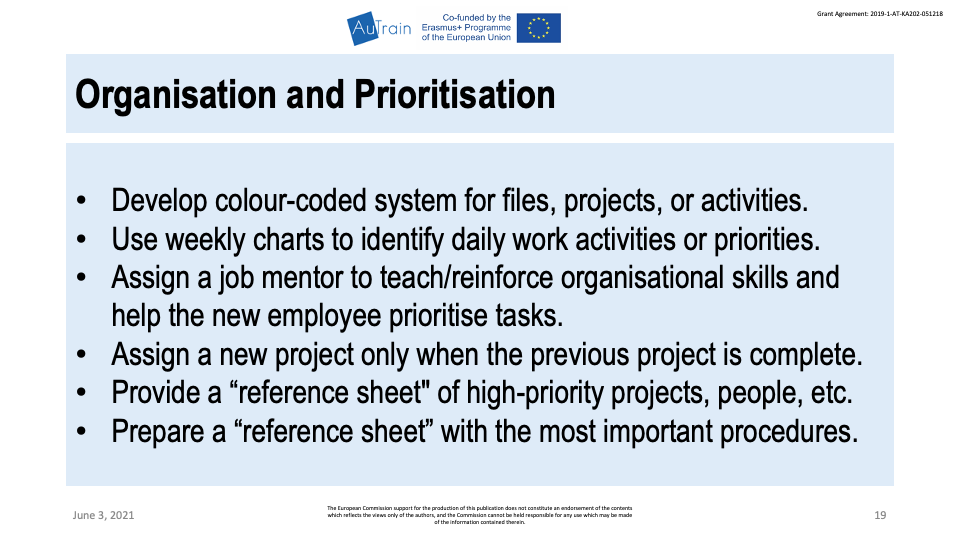

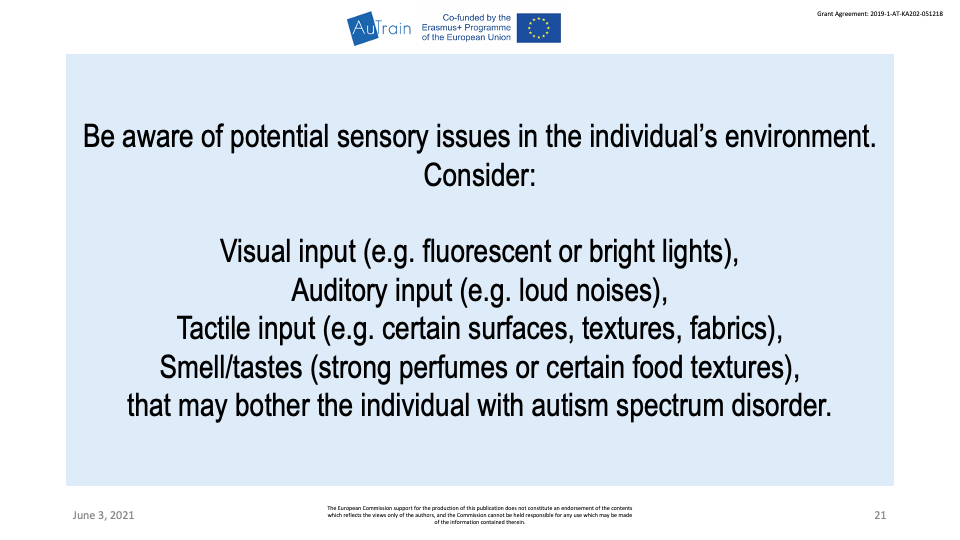
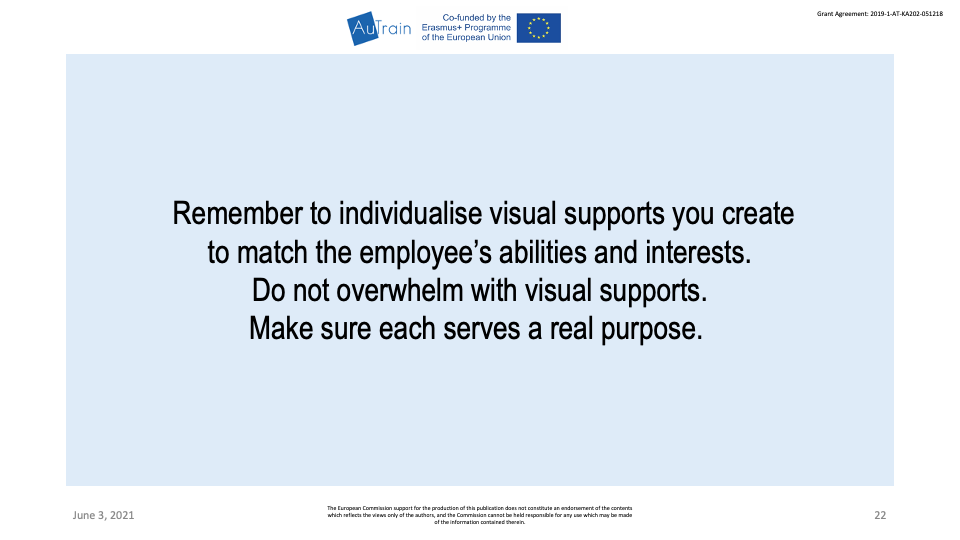
Organisation and Prioritisation
- Develop color-coded system for files, projects, or activities.
- Use weekly charts to identify daily work activities or priorities.
- Assign a job mentor to teach/reinforce organisational skills and help the new employee prioritise tasks.
- Assign a new project only when the previous project is complete.
- Provide a “reference sheet“ of high-priority projects, people, etc.
- Prepare a “reference sheet” with the most important procedures.
When teaching a new skill or behavior:
- Address employee motivation by using highly motivating reinforcers.
- Highly motivating reinforcers may include fixations or fascinations.
- Be sure all staff know what skill is being reinforced and how often.
- Be consistent.
Be aware of potential sensory issues in the individual’s environment. Consider:
- Visual input (e.g. fluorescent or bright lights),
- Auditory input (e.g. loud noises),
- Tactile input (e.g. certain surfaces, textures, fabrics),
- Smell/tastes (strong perfumes or certain food textures), that may bother the individual with autism spectrum disorder.
Remember
- To individualise visual supports you create to match the employee’s abilities and interests.
- Do not overwhelm with visual supports.
- Make sure each serves a real purpose.
Ask for comments, doubts, or questions
Note: Present slides number 23 to 27
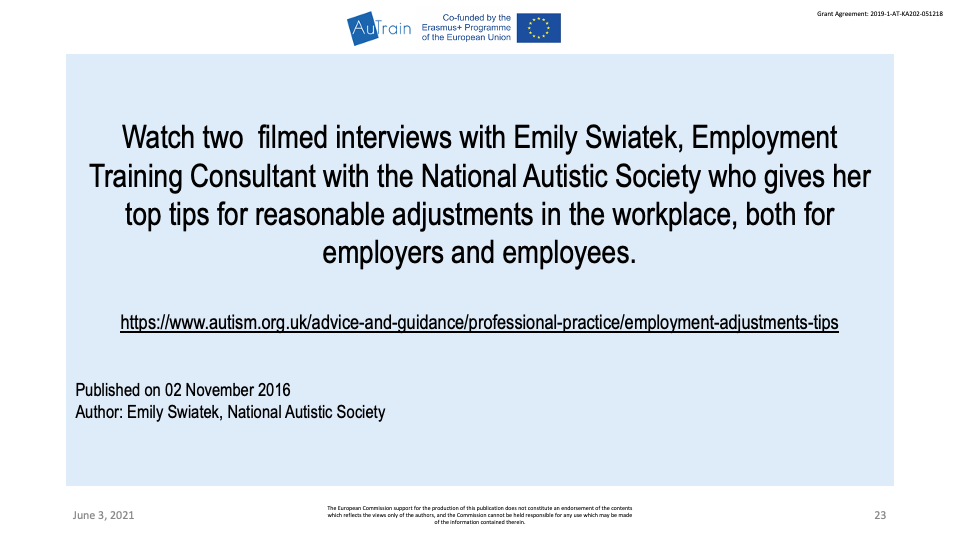
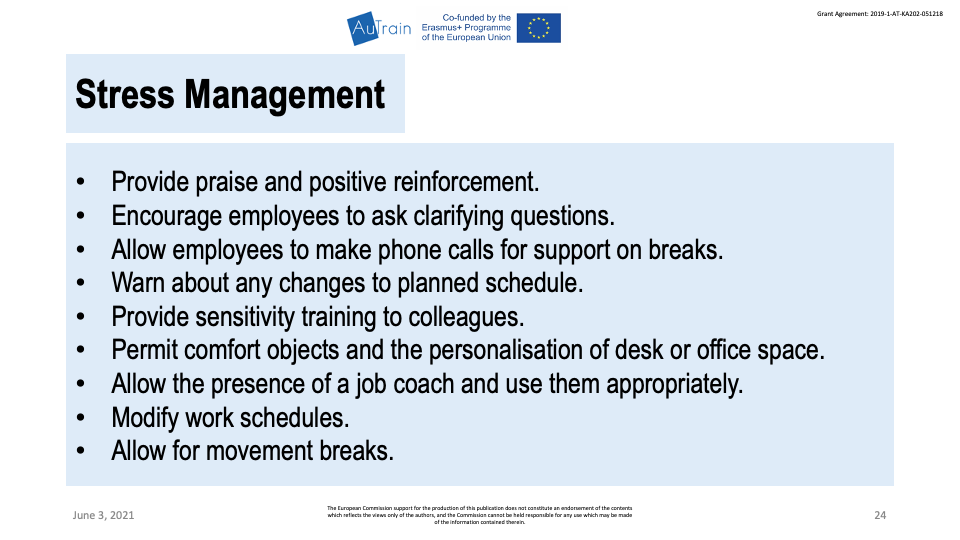
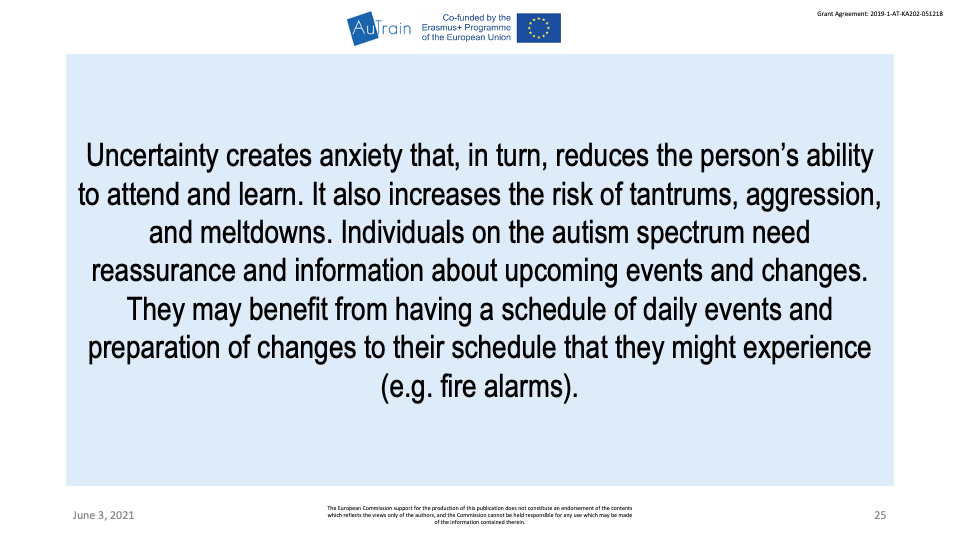
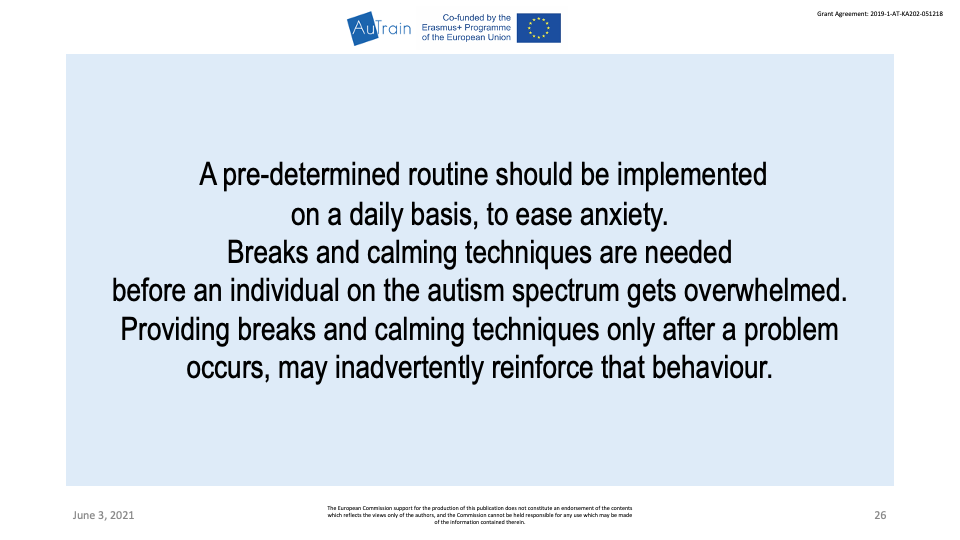
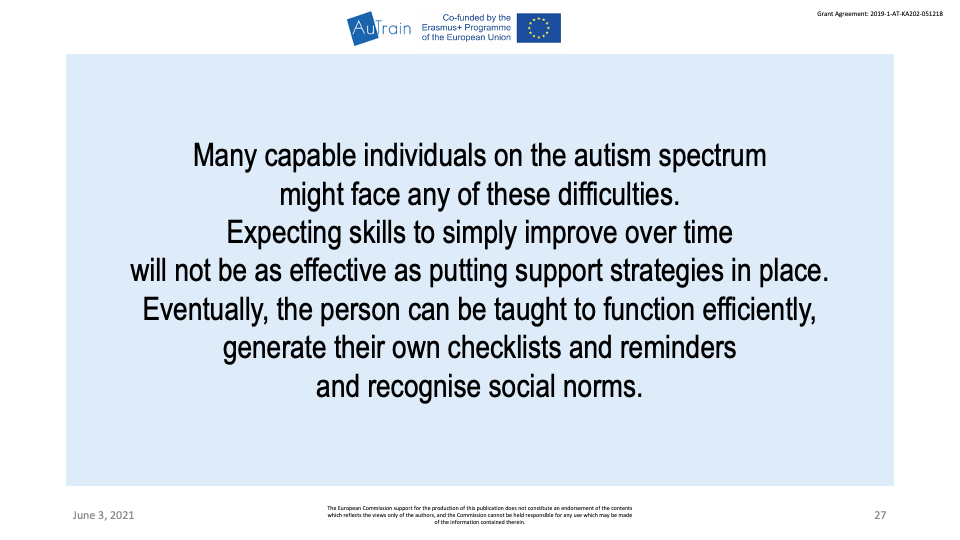
Watch the video
a. Watch the video on the top tips for reasonable adjustments in the workplace, both for employers and employees.
Stress Management
- Provide praise and positive reinforcement.
- Encourage employees to ask clarifying questions.
- Allow employees to make phone calls for support on breaks.
- Warn about any changes to planned schedule.
- Provide sensitivity training to colleagues.
- Permit comfort objects and the personalisation of desk or office space.
- Allow the presence of a job coach and use them appropriately.
- Modify work schedules.
- Allow for movement breaks.
Consider:
1. A pre-determined routine should be implemented on a daily basis, to ease anxiety. Breaks and calming techniques are needed before an individual on the autism spectrum gets overwhelmed. Providing breaks and calming techniques only after a problem occurs, may inadvertently reinforce that behaviour.
2. Many capable individuals on the autism spectrum might face any of these difficulties. Expecting skills to simply improve over time will not be as effective as putting support strategies in place. Eventually, the person can be taught to function efficiently, generate their own checklists and reminders and recognise social norms.
Ask for comments, doubts, or questions
Watch the video
Note: Present slides number 28 to 31
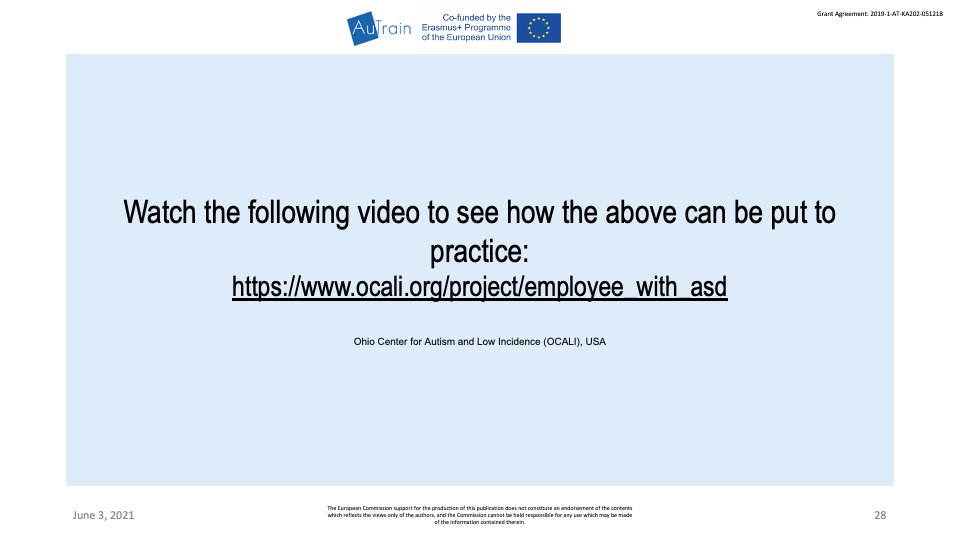
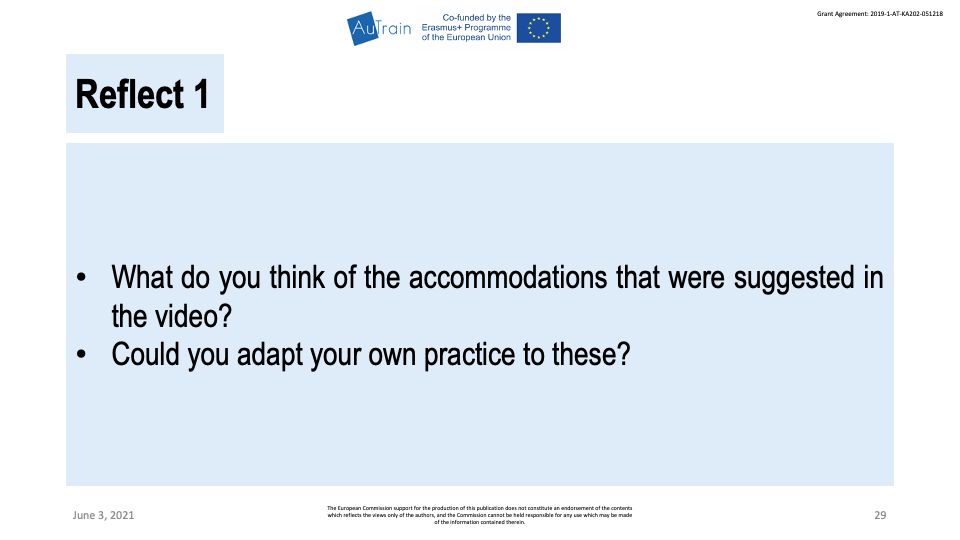

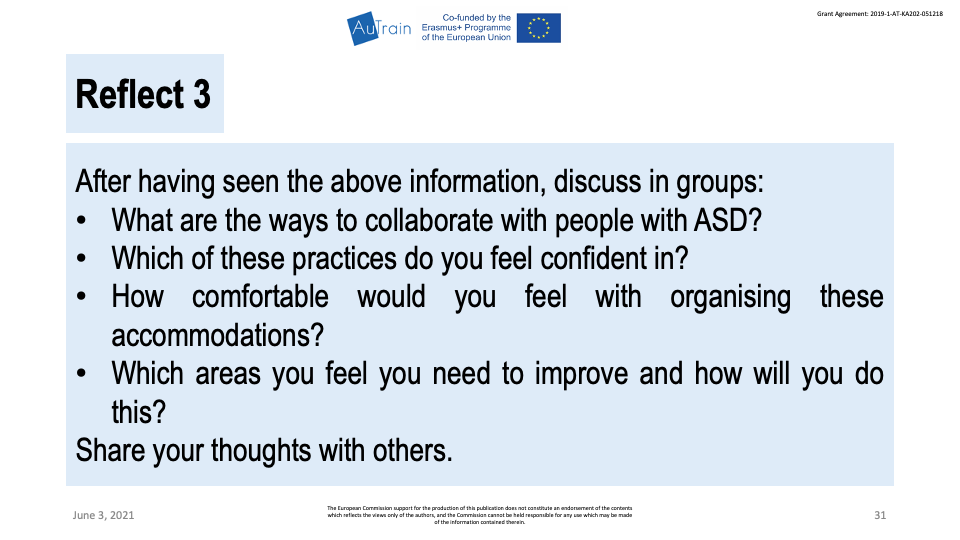
b. Watch the video Hiring Autistic Workers ( https://www.youtube.com/watch?v=3b5OGx-v6Ao)
c. Watch the video about The Employee with Autism Spectrum Disorder ( https://www.ocali.org/project/employee_with_asd)
d. Read out loud the questions for reflection:
Reflect 1:
- What do you think of the accommodations that were suggested in the video? – Could you adapt your own practice to these?
Reflect 2:
Refer to the Worksheet Comprehensive Autism Planning System (CAPS) 6-Minute Brief. In pairs, think of an imaginary example using the template. Share your scenarios this with others and discuss your ideas.
Reflect 3:
After having seen the above information, discuss in groups:
- What are the ways to collaborate with people with ASD?
- Which of these practices do you feel confident in?
- How comfortable would you feel with organising these accommodations?
- Which areas you feel you need to improve and how will you do this?
Share your thoughts with others.
#5. Discuss and Overview 1
Note: Present slide number 32
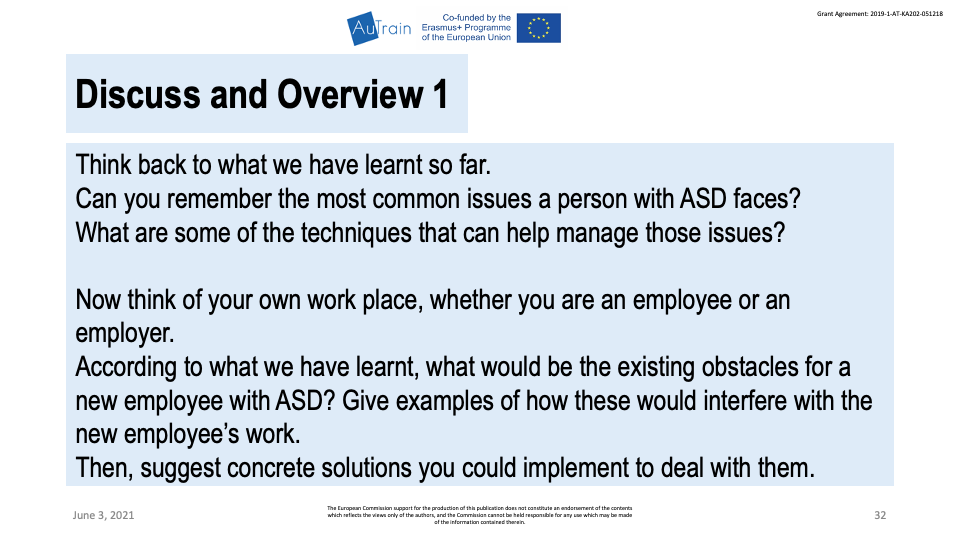
Think back to what we have learnt so far.
- Can you remember the most common issues a person with ASD faces?
- What are some of the techniques that can help manage those issues?
- Now think of your own workplace, whether you are an employee or an employer.
- According to what we have learnt, what would be the existing obstacles for a new employee with ASD?
-
Give examples of how these would interfere with the new employee’s work. Then, suggest concrete solutions you could implement to deal with them.
BREAK TIME
10:15 – 10:45
#6. Introduce the content – Features of community services and their impact on usability for people with ASD- by reading the following text out load. In the end ask for com-ments, doubts, or questions
Note: Present slides number 34 and 35
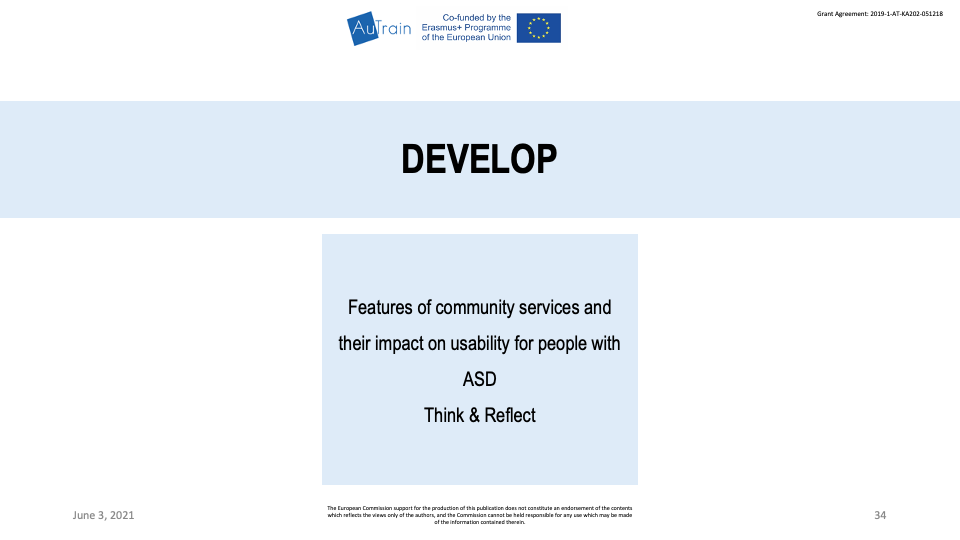
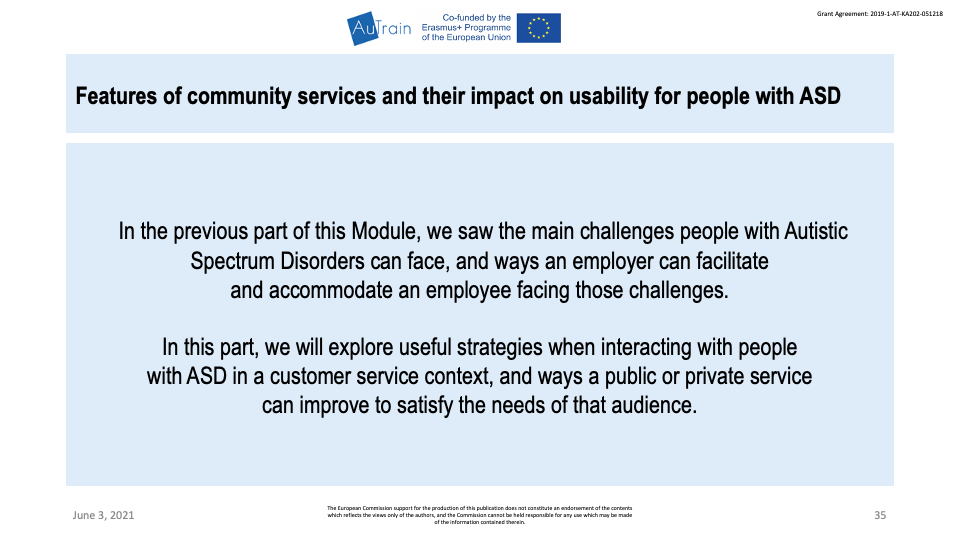
In the previous part of this Module, we saw the main challenges people with Autistic Spectrum Disorders can face, and ways an employer can facilitate and accommodate an employee facing those challenges.
In this part, we will explore useful strategies when interacting with people with ASD in a customer service context, and ways a public or private service can improve to satisfy the needs of that audience.
But first we aim to:
– Brief introduction to autism and things that need to be considered when a client has an ASD (lack of ability to react appropriately to social rules, sensitivity to sounds, touch, tastes, smells, light or colors).
Note: Present slides number 36 to 38
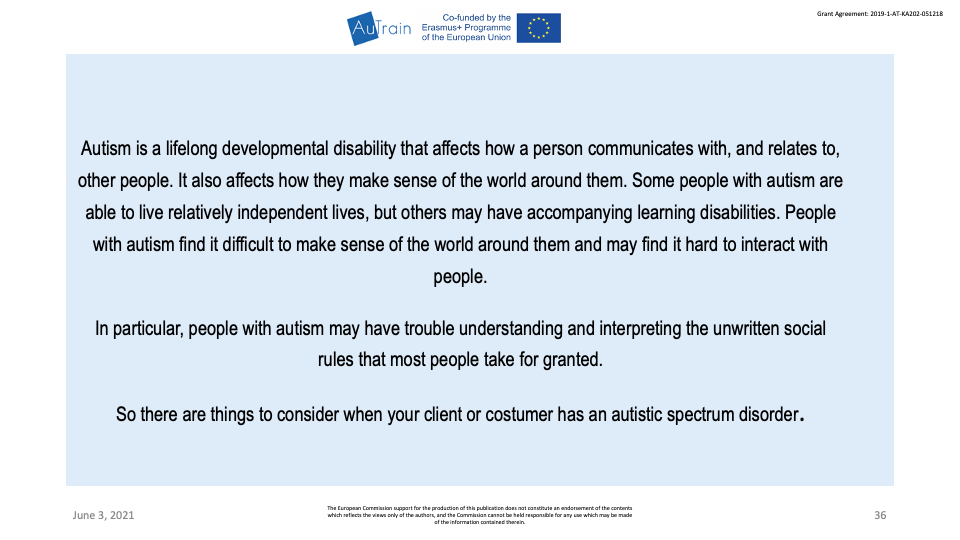
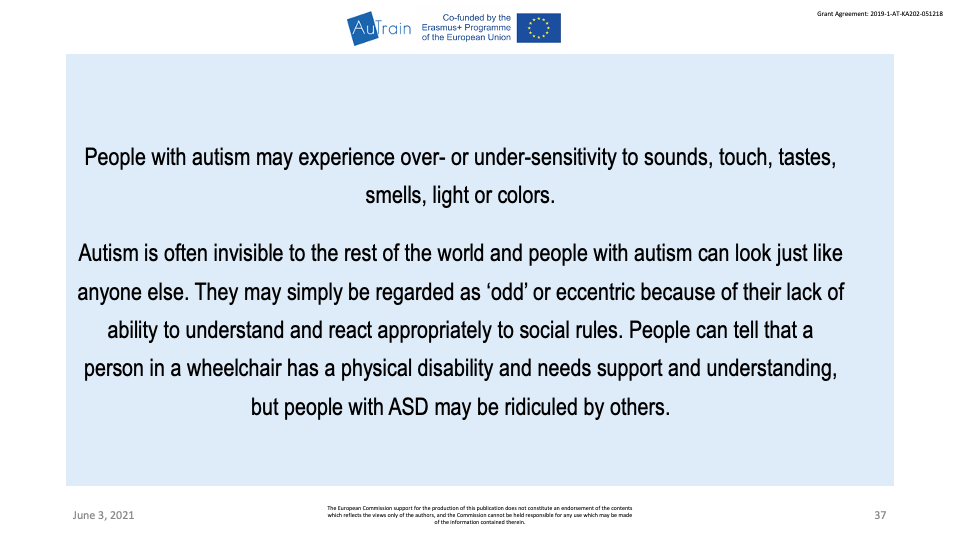
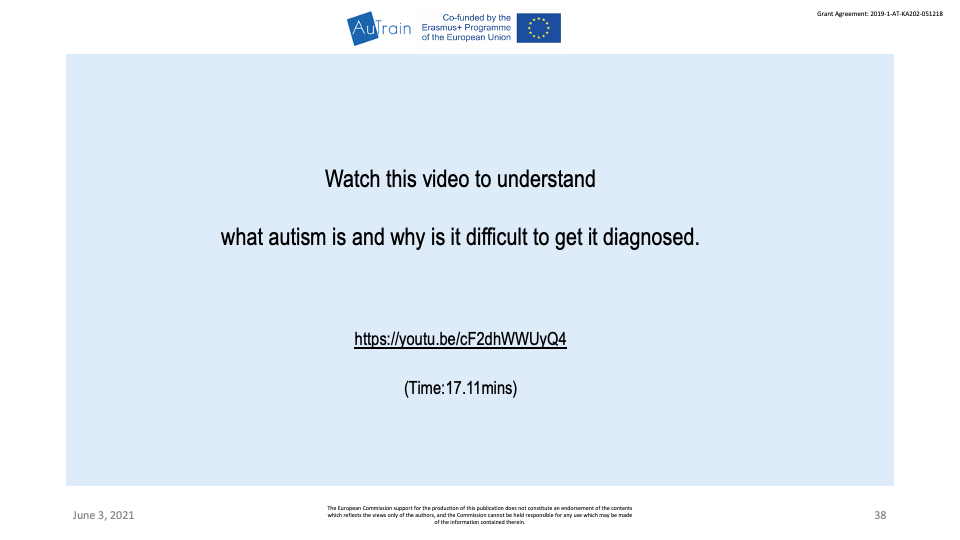
Autism is a lifelong developmental disability that affects how a person communicates with, and relates to, other people. It also affects how they make sense of the world around them. Some people with autism are able to live relatively independent lives, but others may have accompanying learning disabilities. People with autism find it difficult to make sense of the world around them and may find it hard to interact with people.
In particular, people with autism may have trouble understanding and interpreting the unwritten social rules that most people take for granted.
So there are things to consider when your client or costumer has an autistic spectrum disorder.
Watch this video to understand what autism is and why is it difficult to get it diagnosed. Video: A Story Of Undiagnosed Autism https://youtu.be/cF2dhWWUyQ4 (Time:17.11mins)
Ask for comments, doubts, or questions
Features of community services and their impact on usability for people with ASD
Note: Present slides number 39 to 41
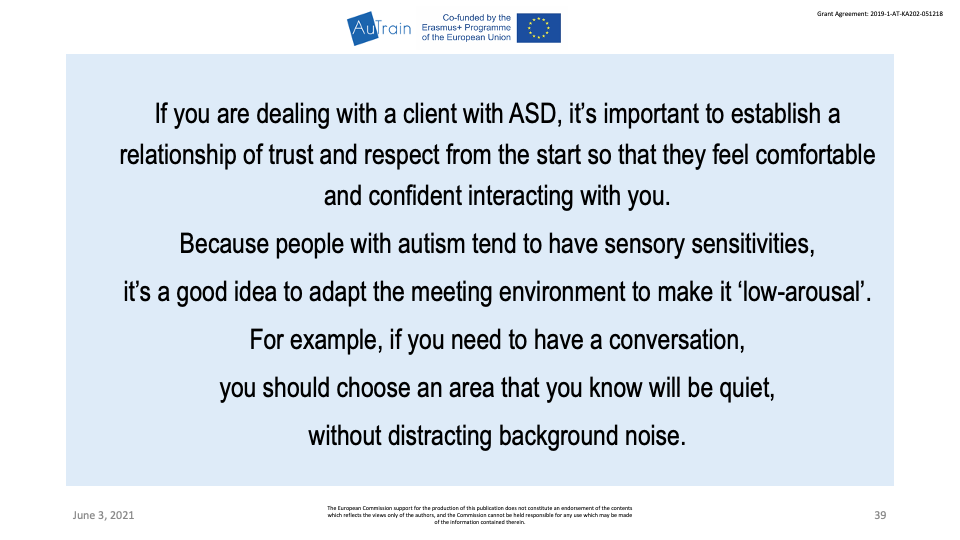
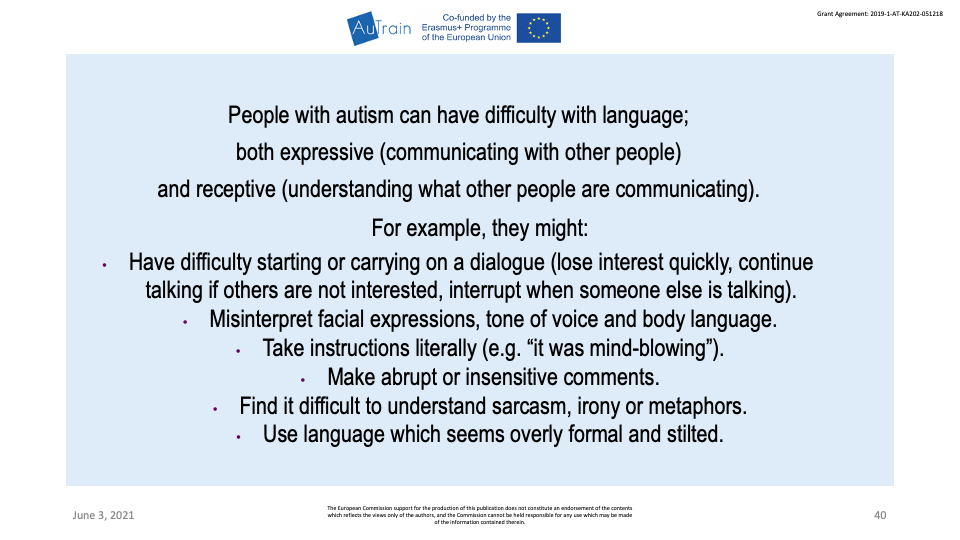
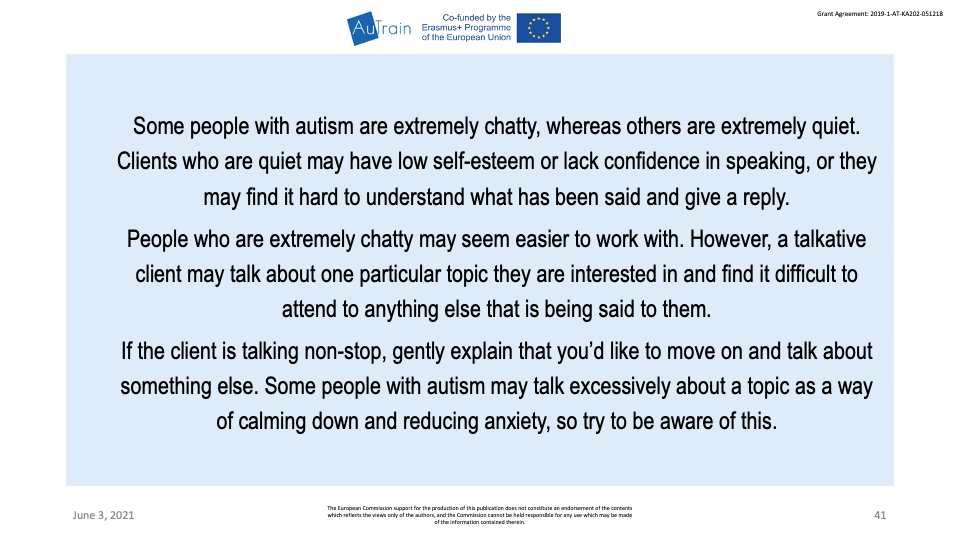
A. If you are dealing with a client with ASD, it’s important to establish a relationship of trust and respect from the start so that they feel comfortable and confident interacting with you. Because people with autism tend to have sensory sensitivities, it’s a good idea to adapt the meeting environment to make it ‘low-arousal’. For example, if you need to have a conversation,
you should choose an area that you know will be quiet, without distracting background noise.
B. People with autism can have difficulty with language; both expressive (communicating with other people) and receptive (understanding what other people are communicating).
For example, they might:
- Have difficulty starting or carrying on a dialogue (lose interest quickly, continue talking if others are not interested, interrupt when someone else is talking).
- Misinterpret facial expressions, tone of voice and body language.
- Take instructions literally (e.g. “it was mind-blowing”).
- Make abrupt or insensitive comments.
- Find it difficult to understand sarcasm, irony or metaphors.
- Use language which seems overly formal and stilted.
C. Some people with autism are extremely chatty, whereas others are extremely quiet. Clients who are quiet may have low self-esteem or lack confidence in speaking, or they may find it hard to understand what has been said and give a reply.
People who are extremely chatty may seem easier to work with. However, a talkative client may talk about one particular topic they are interested in, and find it difficult to attend to anything else that is being said to them.
If the client is talking non-stop, gently explain that you’d like to move on and talk about something else. Some people with autism may talk excessively about a topic as a way of calming down and reducing anxiety, so try to be aware of this.
Ask for comments, doubts, or questions
Note: Present slides number 42 to 44
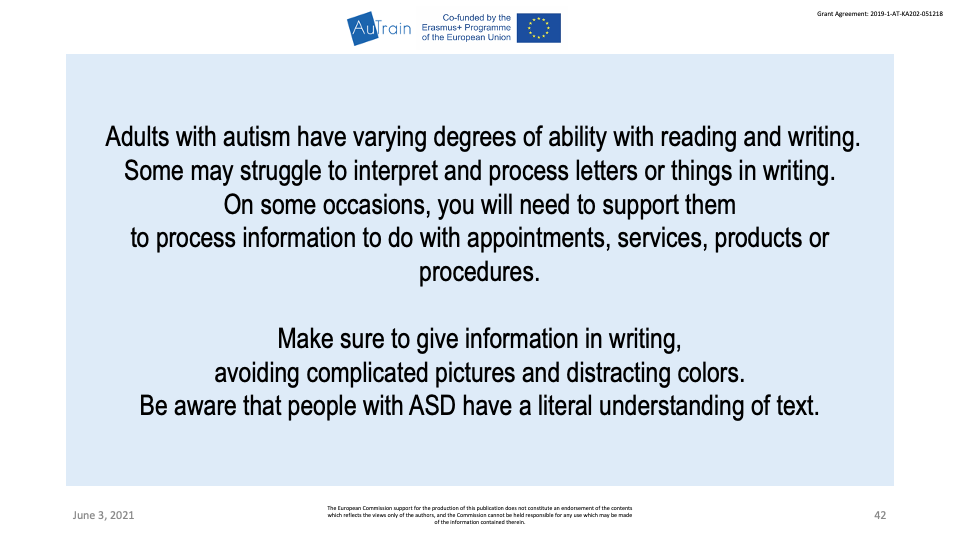
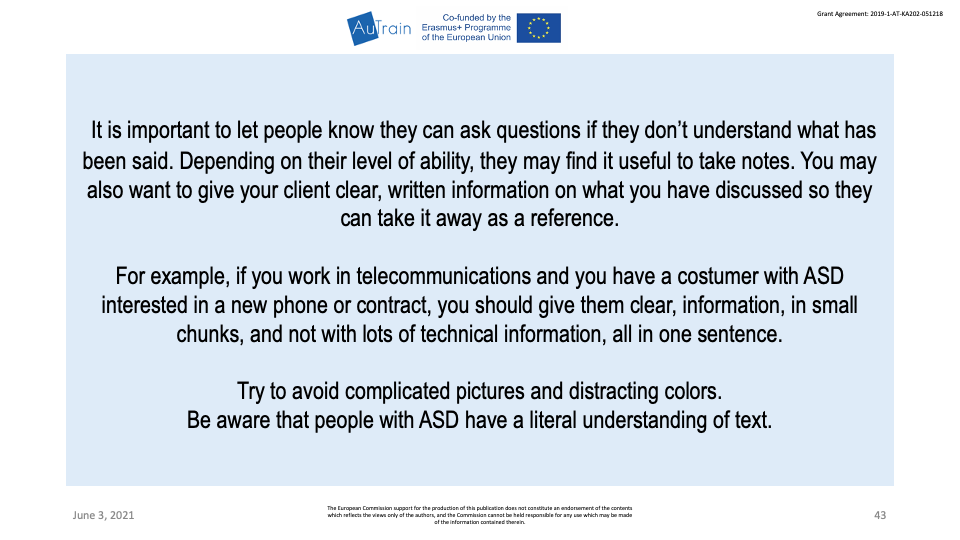
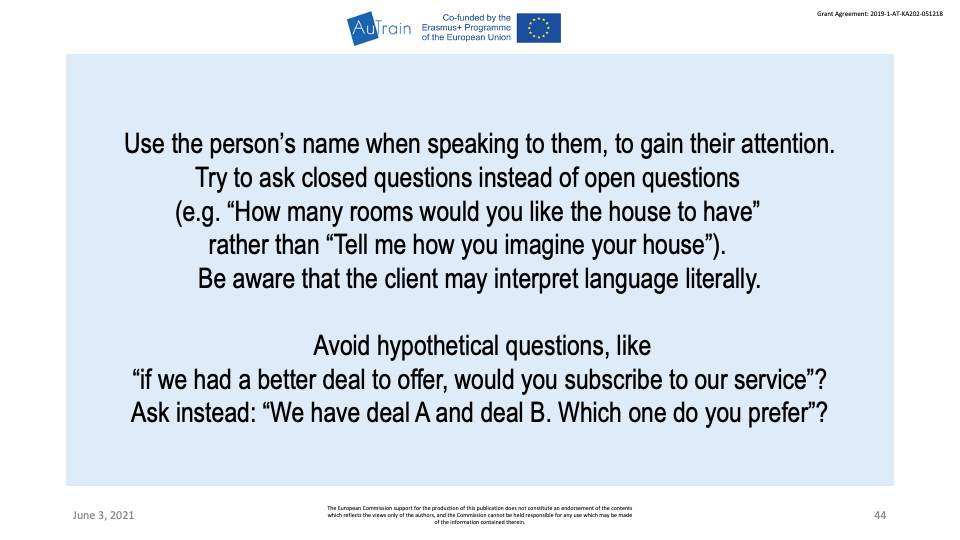
D. Adults with autism have varying degrees of ability with reading and writing. Some may struggle to interpret and process letters or things in writing. On some occasions, you will need to support them to process information to do with appointments, services, products or procedures. Make sure to give information in writing, avoiding complicated pictures and distracting colors. Be aware that people with ASD have a literal understanding of text.
E. It is important to let people know they can ask questions if they don’t understand what has been said. Depending on their level of ability, they may find it useful to take notes. You may also want to give your client clear, written information on what you have discussed so they can take it away as a reference.
For example, if you work in telecommunications and you have a costumer with ASD interested in a new phone or contract, you should give them clear, information, in small chunks, and not with lots of technical information, all in one sentence.
Try to avoid complicated pictures and distracting colors.
Be aware that people with ASD have a literal understanding of text.
F. Use the person’s name when speaking to them, to gain their attention.
Try to ask closed questions instead of open questions (e.g. “How many rooms would you like the house to have” rather than “Tell me how you imagine your house”). Be aware that the client may interpret language literally. Avoid hypothetical questions, like
- “if we had a better deal to offer, would you subscribe to our service”?
- Ask instead: “We have deal A and deal B. Which one do you prefer”?
Ask for comments, doubts, or questions
Note: Present slides number 45 to 47
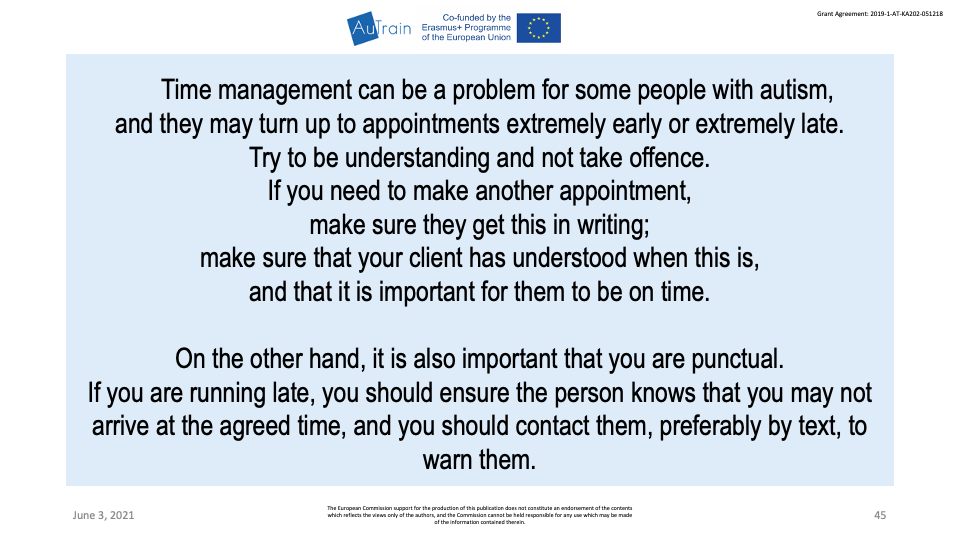
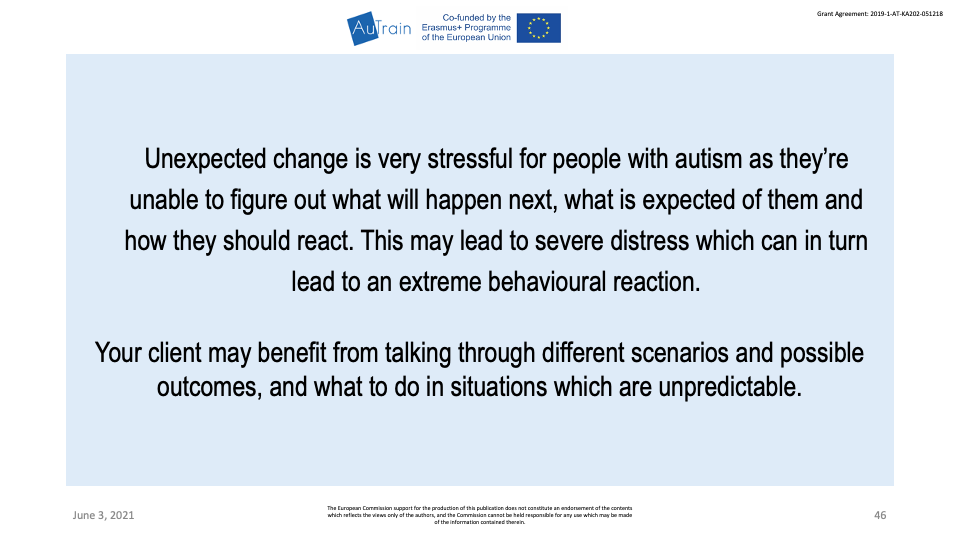
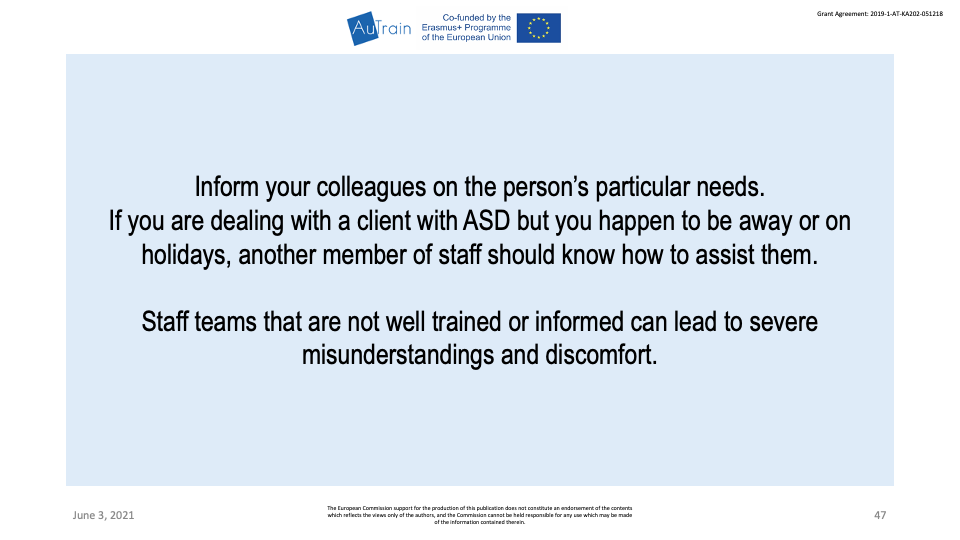
G. Time management can be a problem for some people with autism, and they may turn up to appointments extremely early or extremely late.Try to be understanding and not take offence. If you need to make another appointment, make sure they get this in writing; make sure that your client has understood when this is, and that it is important for them to be on time.
On the other hand, it is also important that you are punctual. If you are running late, you should ensure the person knows that you may not arrive at the agreed time, and you should contact them, preferably by text, to warn them.
H. Unexpected change is very stressful for people with autism as they’re unable to figure out what will happen next, what is expected of them and how they should react. This may lead to severe distress which can in turn lead to an extreme behavioural reaction. Your client may benefit from talking through different scenarios and possible outcomes, and what to do in situations which are unpredictable.
I. Inform your colleagues on the person’s particular needs. If you are dealing with a client with ASD but you happen to be away or on holidays, another member of staff should know how to assist them. Staff teams that are not well trained or informed can lead to severe misunderstandings and discomfort.
Ask for comments, doubts, or questions
Watch this video
Note: Present slide number 48
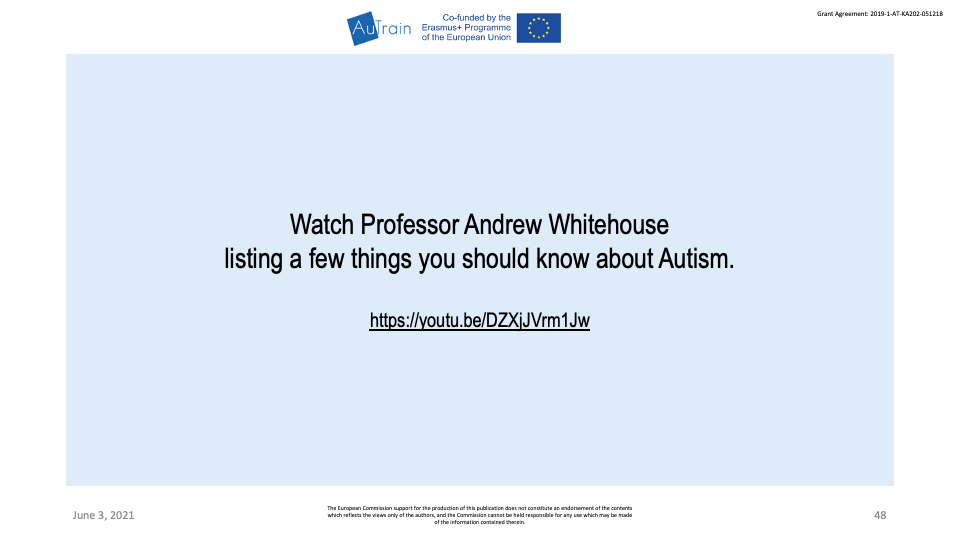
Watch Professor Andrew Whitehouse- listing a few things you should know about Autism: https://youtu.be/DZXjJVrm1Jw . Discuss the video
Note: Present slides number 49 to 51
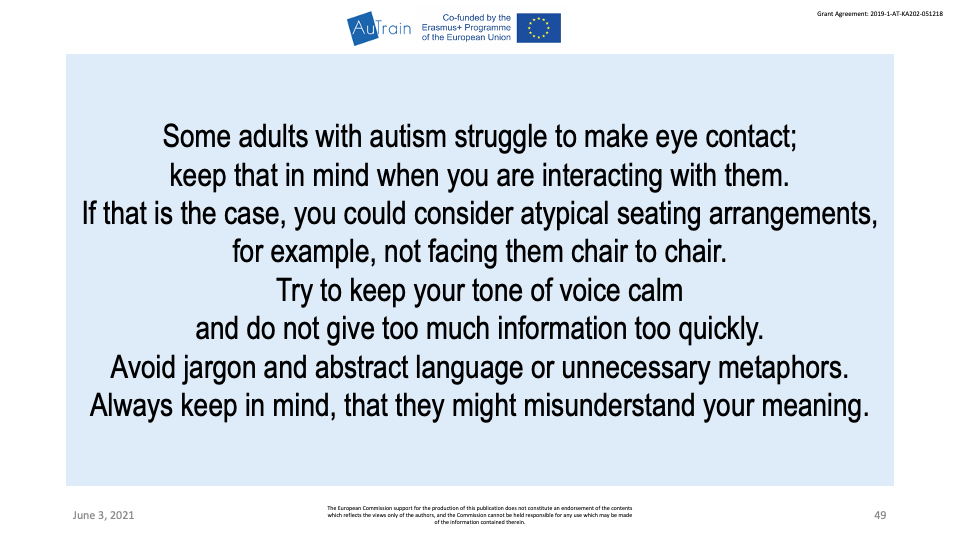
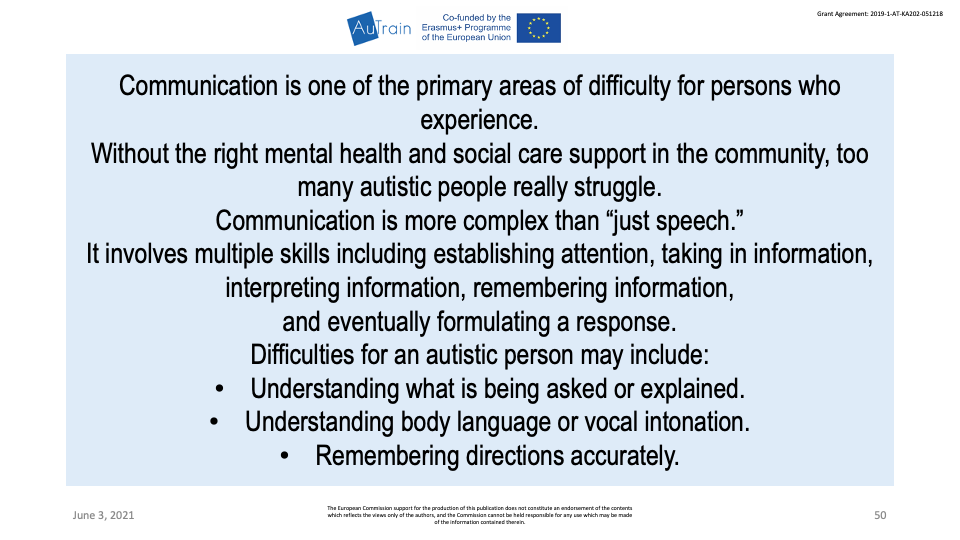
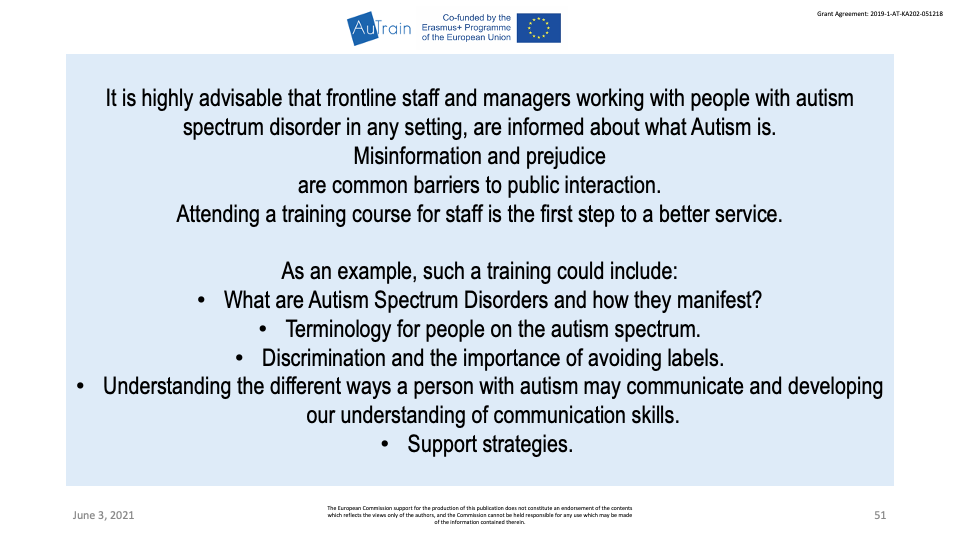
J. Some adults with autism struggle to make eye contact; keep that in mind when you are interacting with them. If that is the case, you could consider atypical seating arrangements,
for example, not facing them chair to chair. Try to keep your tone of voice calm and do not give too much information too quickly. Αvoid jargon and abstract language or unnecessary metaphors. Always keep in mind, that they might misunderstand your meaning.
K. Communication is one of the primary areas of difficulty for persons who experience. Without the right mental health and social care support in the community, too many autistic people really struggle. Communication is more complex than “just speech.” It involves multiple skills including establishing attention, taking in information, interpreting information, remembering information, and eventually formulating a response. Difficulties for an autistic person may include:
- Understanding what is being asked or explained.
- Understanding body language or vocal intonation.
- Remembering directions accurately.
L. It is highly advisable that frontline staff and managers working with people with autism spectrum disorder in any setting, are informed about what Autism is. Misinformation and prejudice are common barriers to public interaction. Attending a training course for staff is the first step to a better service.
As an example, such a training could include:
- What are Autism Spectrum Disorders and how they manifest?
- Terminology for people on the autism spectrum.
- Discrimination and the importance of avoiding labels.
- Understanding the different ways a person with autism may communicate and developing our understanding of communication skills.
- Support strategies
Ask for comments, doubts, or questions
Note: Present slides number 52 to 56
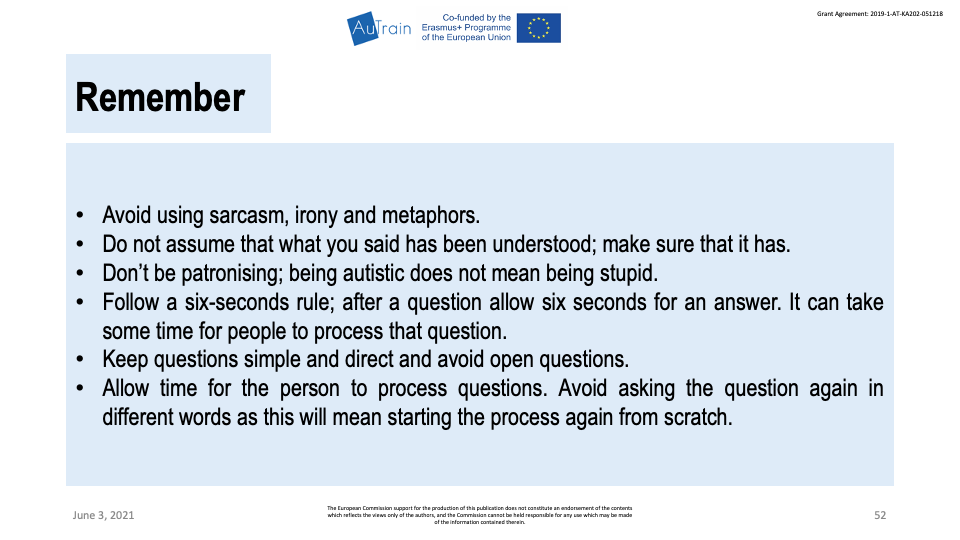
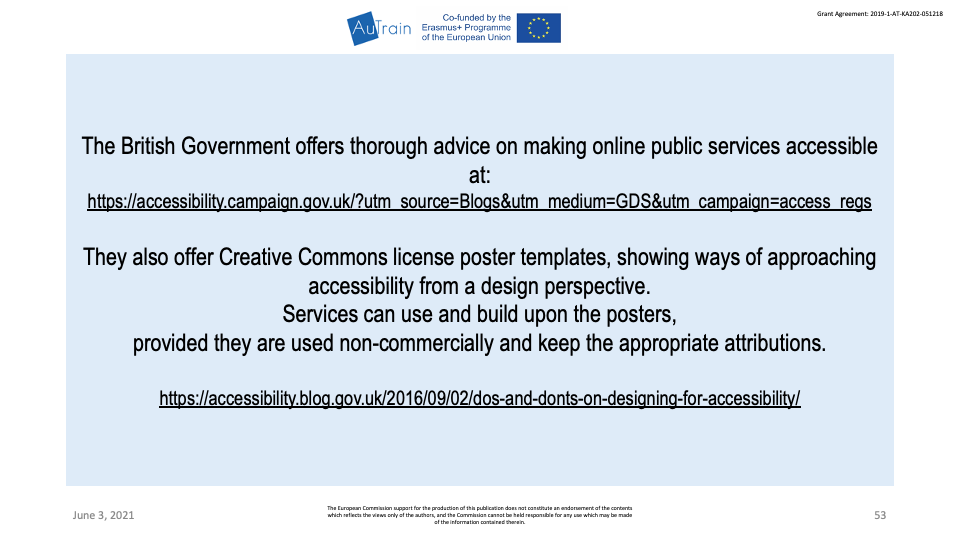
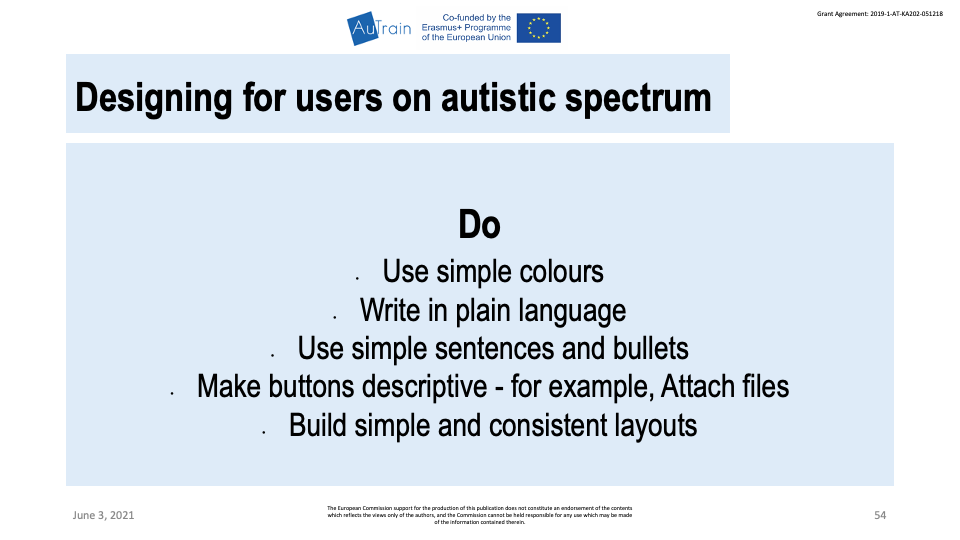
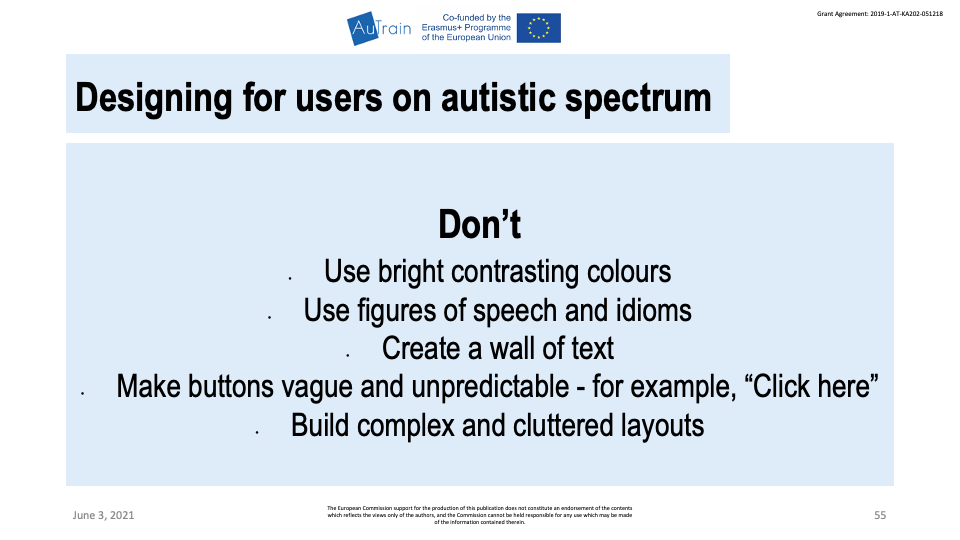
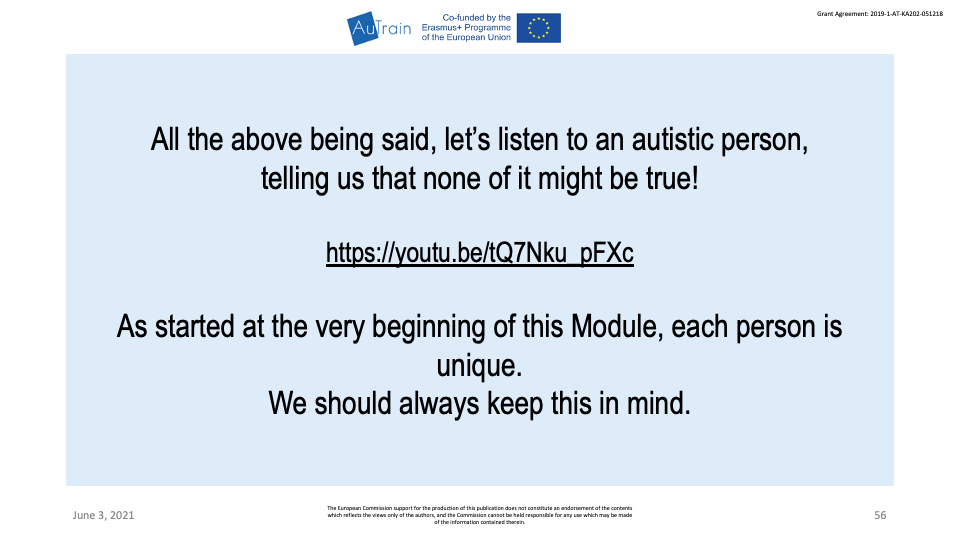
M. Remember:
- Avoid using sarcasm, irony and metaphors.
- Do not assume that what you said has been understood; make sure that it has.
- Don’t be patronising; being autistic does not mean being stupid.
- Follow a six-seconds rule; after a question allow six seconds for an answer. It can take some time for people to process that question.
- Keep questions simple and direct and avoid open questions.
- Allow time for the person to process questions. Avoid asking the question again in different words as this will mean starting the process again from scratch.
N. The British Government offers thorough advice on making online public services accessible at: https://accessibility.campaign.gov.uk/?utm_source=Blogs&utm_medium=GDS&utm_campaign=access_regs
They also offer Creative Commons license poster templates, showing ways of approaching accessibility from a design perspective.
Services can use and build upon the posters, provided they are used non-commercially and keep the appropriate attributions.
https://accessibility.blog.gov.uk/2016/09/02/dos-and-donts-on-designing-for-accessibility/
O. Designing for users on the autistic spectrum
Do
- Use simple colors
- Write in plain language
- Use simple sentences and bullets
- Make buttons descriptive – for example, Attach files
- Build simple and consistent layouts
P. Designing for users on the autistic spectrum
Don’t
- Use bright contrasting colors
- Use figures of speech and idioms
- Create a wall of text
- Make buttons vague and unpredictable – for example, “Click here”
- Build complex and cluttered layouts
Q. Watch the video: All the above being said, let’s listen to an autistic person, telling us that none of it might be true!
As started at the very beginning of this Module, each person is unique.
We should always keep this in mind.
#7. Introduce Think & Reflect
Note: Present slides number 57 to 58
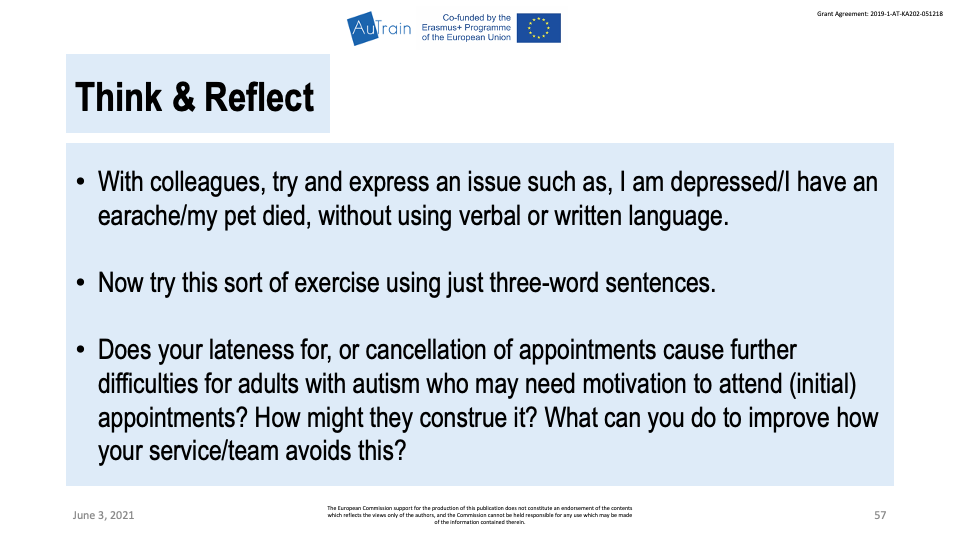
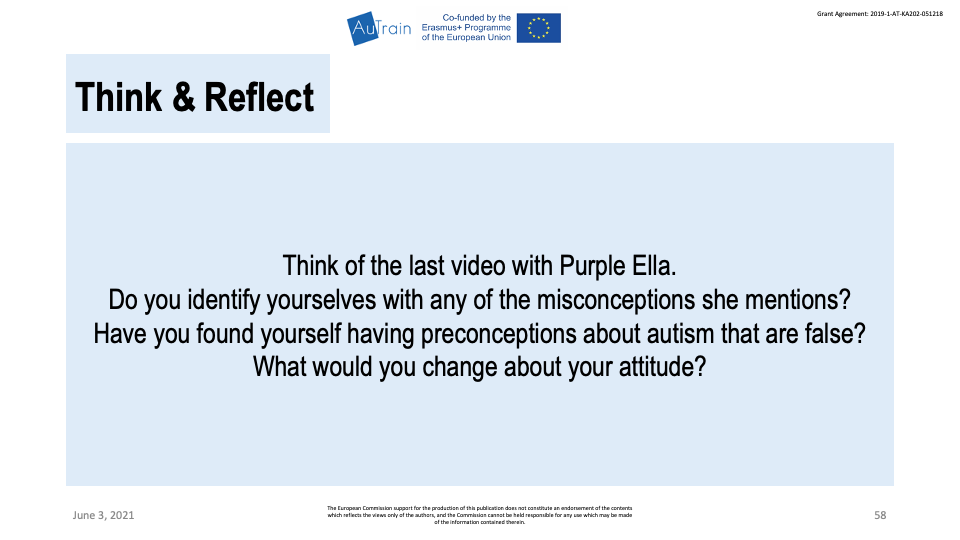
Think & Reflect:
With colleagues, try and express an issue such as, I am depressed/I have an earache/my pet died, without using verbal or written language.
Now try this sort of exercise using just three-word sentences.
Does your lateness for, or cancellation of appointments cause further difficulties for adults with autism who may need motivation to attend (initial) appointments? How might they construe it? What can you do to improve how your service/team avoids this?


